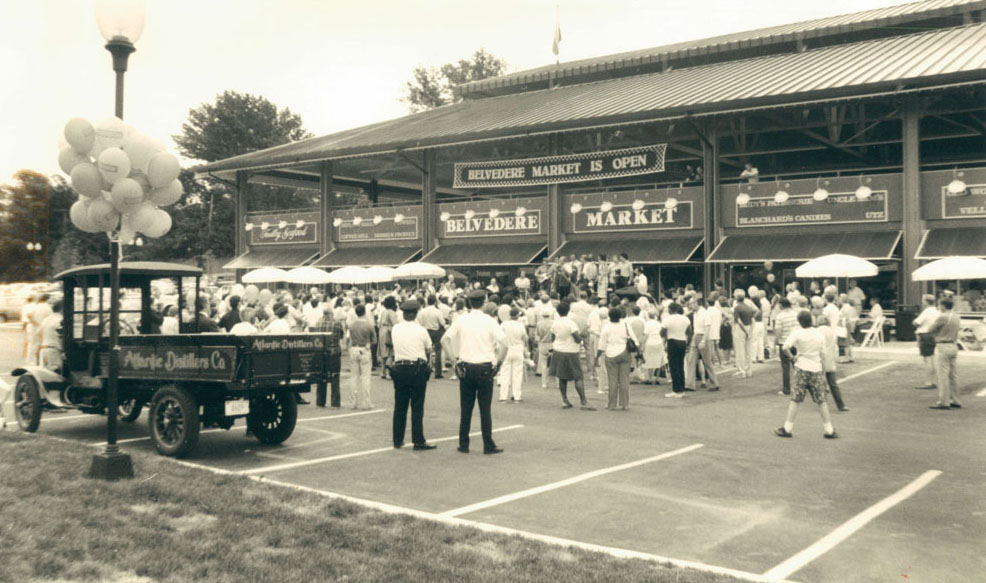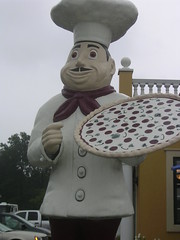Pizza Trust
Belvedere Square
529 E. Belvedere Ave
Pizza Club (not its individual members, but the disembodied
collective voice of Pizza Club) does not like board games. Pizza Club does not
understand board games. Why are they played? What is the source of enjoyment?
Especially Monopoly. Monopoly makes us weep with mystification. We were
reminded of this when reading up on America’s first Gilded Age, in the last
decades of the nineteenth century, which served as the model for that dreaded
game. It was a time of unbridled corporate power and greed, dominated by gargantuan
trusts – Rockefeller’s Standard Oil, J.P. Morgan’s US Steel, the Northern
Securities Company which briefly owned all the railroads from sea to sea –
crushing workers and consumers alike under their heels.
The game of Monopoly, originally intended to make people
question the moral legitimacy of this system, famously
did the opposite
and taught us that cutthroat real estate dealing is wholesome fun for the entire
family – which it is, ask Jared Kushner. The abstracted pantomime of the “game,”
where everyone starts equal and obeys the same rules, helps our brains
accommodate the obscene exploitation of bodies and resources that we observe in
the real world. When people threaten to take away the obscene exploitation of
bodies and resources, that is called socialism, and it’s the most frightening
thing imaginable. There would obviously be nothing left to do that is “fun”
under those conditions.
These thoughts bubbled to the surface of Pizza Club’s melty
cheesebrain as we visited Belvedere Square, a shopping center just inside the
city’s northern limits. In that place has arisen the headquarters of a great
Pizza Trust which claims to serve “Baltimore’s
best pizza.” The Pizza Trust began operations about a year ago, which makes
it quite remarkable that they have already received the designation of “best
pizza” from the Pizza Oversight Authorities. Perhaps they acquired some smaller
pizza company which came with this superlative, or perhaps the wheels of
justice have been greased. Our investigators did turn up an unusual amount of
grease, but we conclude that the Pizza Trust is in fact a whimsical evocation
of corporate
monopoly, and actually controls no means of production beyond the equipment
and materials in its humble rented stall. We will first speak of these greasy
materials, and then of the game in which the Pizza Trust merely occupies a
square within a square within a square. Within a game board that is also just a
square in a larger gameboard! Oh my god!
To set the scene, we should clarify that Belvedere Square contains
numerous retail spaces arrayed around the large postmodern shed designated
“Belvedere Square Market” (the rustic roof conceals a parking deck). The Market is
modeled on the public markets of olden days, where various food producers would
gather to sell their goods. In the early 1980s, white suburbanites nostalgic
for the downtown public spaces they remembered but were afraid to visit built simulacra
such as this. The Market offered heavily marked-up produce, meats, dry goods,
etc. alongside prepared foods. Today, however, wealthy people have raw
foodstuffs delivered to their homes in elaborate plastic sarcophagi;
we don’t really know how poor people get food but many of them seem to still be
alive. The only reason the bourgeoisie go outside is to visit food halls, and
Belvedere Market transformed into the city’s first food hall in the early 2000s
with a few gentle strokes of the Invisible Hand.
Though Pizza Trust is not the best pizza in Baltimore, it’s
the best pizza we’ve had in a food hall. If in the future the city becomes one
giant mixed-use megadevelopment with a food hall on the ground floor/pontoon
level, we would nominate Pizza Trust to go there.
 |
| The Market Pie (a metonym for the place that used to sell vegetables but now sells only this prepared food with vegetables on it) |
Don’t be appalled, dear reader, but Pizza Club doesn’t
really want to write about pizza. You should know this by now. We are only
continuing the work that began long ago, and will continue as long as cheese exists. Here it goes: the pies at Pizza Trust are oblong and would furnish a
meal for two people. You could eat one by yourself if necessary. They offer a
creative array of specialties, some quite beautiful in appearance, shimmering
with greens, yellows, and reds.
 |
| The Mobtown |
The crust is thin, “gentle and light” but with
“enough thickness and moisture to be satisfying,” forming a dynamic gradient
from soft to crunchy. It has charred spots which release carbon flavor like
delicate wisps of smoke. We experienced premium cheese and toppings and
inventive use of sauces. Notably, the “Market” pie has a roasted red pepper and
carrot sauce that pleased club members, providing the sweetness of a tomato
sauce but with an unexpected rooty profile that compliments parmesan. The
distance between pepperonis was just right.
 |
| Pepperoni (did not write down funny name) |
The specialty pies, though coherently planned around
distinct flavor profiles, sometimes indulged in excess. The “Mobtown” balanced
so many ingredients that they “rolled off the slice” and left the center of the
pie rather damp. “Truffled white sauce” poured from a mushroom slice “like the
frosting on toaster strudels.” The mushroom pizza is unpleasantly named the
“Funcle”. Also, “truffled.”
Why “roasted wild mushrooms” when you have roasted regular mushrooms? It’s fine
to just say mushrooms. Your expensive words do not please us.
 |
| Funcle |
Quibbles must be aired through the Pizza Club consensus
process, but in the end we were very happy with our pizzas, ranking them above other
local “fast bake” fare. You don’t go to a food hall specifically for pizza;
rather, you go for the scenario of curated choice and once in that scenario,
you decide that you want pizza and locate the designated pizza vendor. One Club
member spoke of Pizza Trust’s pie as a flattened version of the ubiquitous
fast-casual “bowl” format. If you live in the neighborhood, it could be your first-line
pizza place – it will make you feel healthier than Pizza Bolis because there is
less food. We also appreciated that the pies were quite affordable for this
sector of the market – between $10.50 and $12.50 for pies comparable to those
which cost $15-$18 at other Neapolitan-style outlets. We have received reports
of significant lines at the Pizza Trust during mealtimes.
“Order ye pizzas while ye may,” advised the poet, and so
must fans of Belvedere Square do. Pizza Trust has lightheartedly appropriated the
“trust” as a vintage aesthetic; the age of railroads and Rockefellers is a funny
reference for a local small business staffed by very courteous teenagers. Yet
the game is still afoot, and the rent comes due every month. Many businesses
have left Belvedere in recent years, finding that even premium prices and a
baked-in clientele can’t satisfy this obligation. It’s just another spin around
the same board.
The first Belvedere Square was built in 1986 by developer
James Ward, II, with a $1.7 million loan from the city which Baltimore forgave
twelve years later. By then, many shops had gone under and Ward wanted to
switch from local businesses to chain-store tenants – he wound up shuttering
the entire site after drawn-out conflicts with business owners and neighborhood
groups. A consortium of big-name developers got $4 million from the city and
state to redevelop the site in 2003, and Scott Plank’s War Horse LLC launched
another rebranding in 2013, building his resume for future bids
on public
markets around the city. This is a very interesting game in that millions
of dollars in public financing magically rains down upon its wealthiest players
whenever they roll the dice. War Horse has put the site up
for sale again; Plank prefers his assets liquid. We recommend the “truffled
white sauce.”
Pizza Trust seems not unaware of this context. “Like
historic Belvedere Square Market,” their web copy declares, “The Pizza Trust is
an instant classic.” Truly we have no time to wait for history to happen – we
must will a fictional past into being, instantly classic, and continually
renovate that past to track market trends. Would you get emotionally attached
to a square on the Monopoly board? The game was supposed to teach us that
losing things is fun. That way we can enjoy the random possibility of winning
something new, or getting crushed by those who are winning.
 |
| Grand opening, 1986 (The Baltimore Sun) |
Elizabeth Magie, Monopoly’s inventor, was one of the first
game designers to format the board as a circuit around which players loop until
the winner is declared. In Baltimore, it’s easy to trace that loop, with developers
circulating through advantaged white-L neighborhoods (except when they build
their own luxury
islands). Someone else will
land on Belvedere Square soon enough. Magie intended for people to play the
game according to her now-forgotten “prosperity” rules, in which generous taxes
on land and rents are redistributed for public goods determined by all players.
For instance, players could nurture the actual public markets and common spaces
which Belvedere Square merely evokes, and give everyone pizza. Stories about Monopoly’s
unexpected origin tend to assume that this version was incredibly boring and no
one wanted to play it. Pizza Club would definitely agree. Why play a game when
you can share real pizza?
6/8 slices
Research and photographs: Graham
















